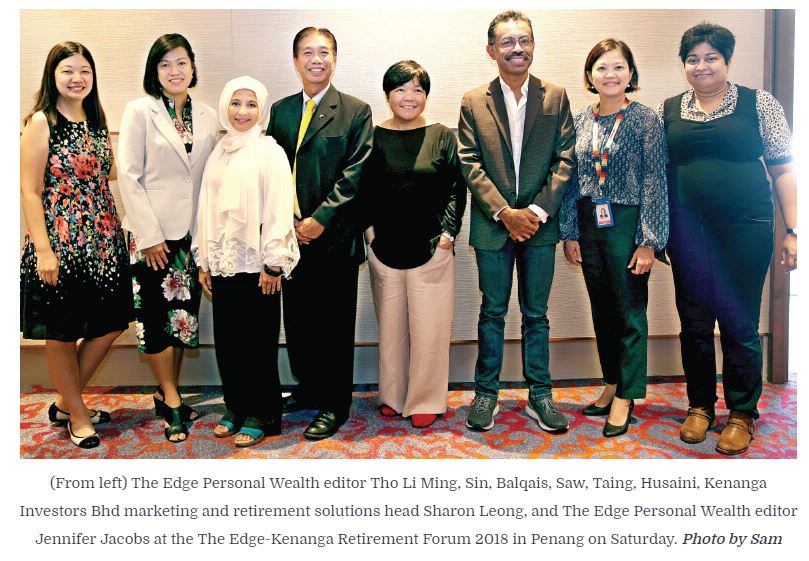Navigating the retirement conundrum

PENANG: As lifespans extend and cost of living increases, planning for retirement has become more challenging. As such, Malaysians need to rethink their financial planning strategies so that they can live a quality post-retirement life, said speakers at The Edge-Kenanga Retirement Forum 2018 held here on Saturday.
“Back then, life was simple. Things didn’t cost so much and older folks would depend on their children to look after them. They didn’t really need a huge retirement nest to live a quality life. But that, I believe, is history. The economic dynamics have changed,” Anna Taing, managing editor of The Edge Communications said in her welcome speech at the forum themed “Navigating the Retirement Conundrum”.
Malaysia will become an ageing nation by 2020, whereby 7% of its population will be over 65 years old. By 2045, the number will reach 14%, which will then define the country as an aged nation.
“Income growth that is not commensurate with the rising cost of living is among the biggest hurdles that make retirement a frightening prospect. Discretionary spending power is limited and very little savings are left come the end of the month. Based on the results of several surveys, less than 25% of the working population said they have enough funds to retire comfortably. To mitigate this, people will need to work longer and redo their financial planning strategies,” Taing said.
Malaysia is one of the fastest ageing nations globally. The country will only take 25 years to move from an ageing to an aged nation, said Balqais Yusoff, head of strategy management department at the Employees Provident Fund (EPF). In comparison, it took France more than 100 years to transition, Balqais said in her presentation titled “Preparing for a Better Tomorrow.”
France was already a high-income nation with the proper facilities for the elderly when it reached the status. But some Malaysians cannot even afford to retire if not for their EPF savings.
“Malaysia has one of the lowest savings to gross domestic product (GDP) ratio in the world at 6% if you take EPF out of the equation. The United States, which does not even have a mandatory savings fund, has a savings to gross domestic product (GDP) ratio at 9%. With EPF, Malaysia achieves a 30% savings to GDP ratio, standing tall when compared with other emerging markets,” Balqais said.
To help its members achieve a more comfortable retirement, EPF has introduced several initiatives. They include allowing self-contributions of more than the statutory contribution rates, abolishing the minimum voluntary contribution limit of RM50 and launching voluntary retirement schemes like i-Saraaan (for those working in the informal sector) and i-Suri (for housewives).
The Private Retirement Scheme (PRS) is another solution established by the government to encourage savings. Husaini Hussin, chief executive officer (CEO) of Private Pension Administrator Malaysia, said the PRS has grown over the years in number of members and assets under management.
Husaini added that incentives for youth who invest in PRS will continue under the new government. Under this incentive, Malaysian youths aged between 20 and 30 years old who invest RM1,000 in a PRS fund will receive a RM1,000 one-off contribution from the government.
In addition, individuals who contributes to PRS funds are also allowed to claim tax relief up to RM3,000 per annum until 2021.
“The relevant authorities are also looking at extending the tax relief beyond 2021 after receiving feedback from industry players,” Husaini said.
Malaysians should also review their insurance policies so that rising medical costs will not eat into their retirement nest, said Sin Chee Kwan, CEO of Fin Freedom Sdn Bhd, in her presentation titled “Retirement is a State of Mind.”
She pointed out that Malaysia has the highest medical inflation in the region, according to the 2018 Global Medical Trends survey report by Willis Towers Watson.
“If you already have one card in hand and you think it’s not enough because of medical inflation, you can save a lot of money in terms of insurance premiums by getting a top-up medical insurance card. Many are not aware of this. Let’s say your basic card covers up to RM50,000, and if the medical cost goes beyond that, the top-up card can cover the rest of the cost,” Sin said.
Proper estate planning will ensure that Malaysians are ready for retirement. But according to Rockwills International Group managing director Saw Leong Aun, people tend to overlook digital assets in that process.
In his session titled “Will Writing for Digital Assets,” he stressed that digital information and electronic devices can be important assets given our expansive digital presence. Testators must prioritise the bequeathing of digital information and electronic devices, just as they would with the more common items like offshore assets, landed properties, insurance plans, bank accounts and fixed deposits.
“Digital assets are quite simply records that are created, recorded, transmitted, or stored in a digital format, or in some other intangible form, through electronic means,” Saw said.
This is a class of items that holds both monetary and sentimental value. Examples of such assets would include social media accounts, blogs, online banking or trading accounts, gaming or cryptocurrency accounts, frequent flier airline miles, hotel rewards points, or files stored in remote, cloud-based servers.
The forum was organised by The Edge Malaysia weekly in partnership with Kenanga Investors Bhd.
Source: Edge Markets,
Date : 8 October 2018







